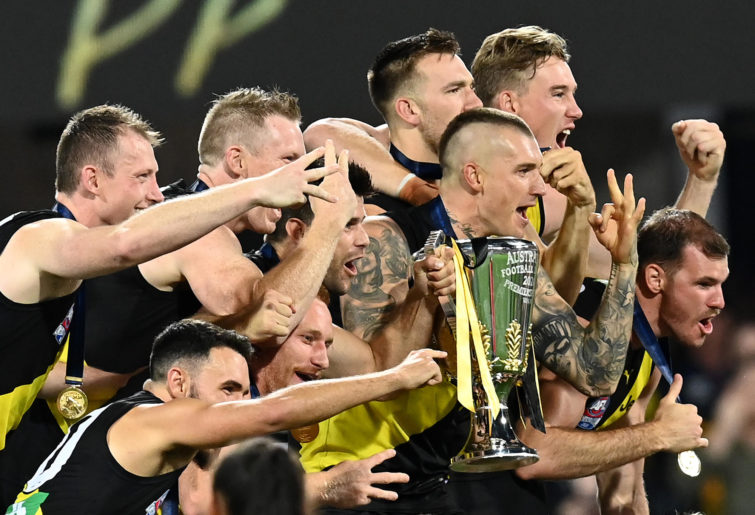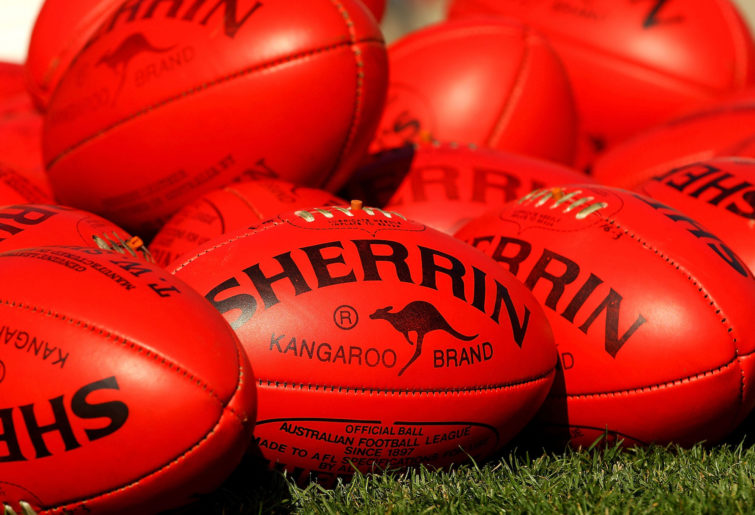Jim Mellas
new author
Roar Rookie
Opinion
Last Saturday night I sat at Marvel Stadium at the Docklands in Melbourne watching the Richmond versus GWS game in a soulless stadium with a crowd of only 18,000.
It was the smallest crowd to attend a Richmond game since 2004, which was one of our many forgotten years.
Earlier in the week Brendon Gale had said that playing the Giants at Marvel would minimise crowds and hurt the club financially. With a crowd of only 18,000, he was correct with both comments.
After the game, Richmond coach Damien Hardwick summed up the fans’ feelings towards the ground by saying: “Mate, I hate coming here. I probably shouldn’t say that… the MCG has got soul, it’s got Richmond people there. Our people don’t come here”.
As a result, there has been a controversy during the week with some AFL experts labelling Richmond fans “precious”. Are they precious or are they right?
Last July on The Roar, I wrote about the biggest stars of the game – the fans who provide the crowds and the atmosphere to make our great game the spectacle that it is.
I wrote about the early months of the COVID season, watching games on television played in empty stadiums without fans. The games were difficult to watch. There were no fans, no noise and absolutely no atmosphere at those early games.
The live telecasts improved somewhat when the television stations improvised with crowd noise special effects, which made for a slightly better viewing experience.
The season was saved because of the hubs in states where crowds were able to attend games. The night grand final at the Gabba in Brisbane was quite a spectacle with a crowd of approximately 30,000 fans.

(Photo by Quinn Rooney/Getty Images)
In 2021 crowds are back at the AFL in Victoria and although initially the crowd capacity was limited, it has increased to now be almost full capacity.
However, crowds are still down this year. It may be due to a fear of COVID, the complex ticketing arrangements or the price of obtaining seats. But nevertheless, crowds are significantly down compared to pre-COVID years.
The season started with Richmond versus Carlton blockbuster opener at the MCG where crowd capacity was at 50 per cent. But regardless of the smaller crowd, the atmosphere was electric when the 2019 and 2020 Richmond premiership flags were unfurled.
Crowd capacity increased so that by Anzac eve the MCG hosted a crowd of 56,418 and the next day 78,113 attended the Anzac Day game at the MCG.
Despite the comparatively smaller crowds, the atmosphere and spectacle of attending a game at the MCG is first class.
Unfortunately, the same cannot be said about the AFL’s stadium at the Docklands. The Docklands stadium is the AFL’s modern-day Football Park, or Arctic Park as it was commonly known in those days.
It is a cold, soulless place that lacks atmosphere and excitement regardless of the size of the crowd. One of the big driving forces behind the creation of the Waverley Park ground was for the VFL/AFL to have their own ground.
At the time most of the VFL grounds, including the MCG, were controlled either by local councils or cricket clubs. The MCG was controlled by the MCC Trust. There were significant politics at play at the time and having their own ground later gave the AFL significant leverage in negotiations with the MCC Trust in relation to the use of the MCG.
The original design of Waverley Park was a stadium with a capacity of over 150,000 fans but that never eventuated, and the capacity was approximately 70,000 fans.
The first game was played at Waverley in 1970 between Fitzroy and Geelong. The stadium was plagued by significant problems. There was a lack of public transport to the stadium. Hundreds of buses would ferry fans in heavy traffic from Glen Waverley railway station to the ground as there was no train line anywhere near the ground.
The roads were clogged with traffic, which made driving to the ground a nightmare. There was parking at the ground, but it would take hours after a game to find your car and then wait in the quagmire of traffic waiting to get out of the ground, which had a very negative impact on the whole AFL experience.
The ground itself looked good with its wooden seats and its impressive, whiz bang, state-of-the-art (for the ’70s) V-shaped electronic scoreboard.
However, compared to the MCG, the ground looked too open and there seemed to be a massive distance between the fence and the boundary line, which made the play seem distant regardless of where you were sitting.
But it was the wind and the regular icy conditions that led to the name Arctic Park. By the time the gates of the ground finally closed in 1996, no one was sad to see its demise – especially after the lacklustre 1991 grand final, which was played at the ground and had the forgettable bat mobile.
The ground may have given the AFL leverage and an ability to obtain a better financial position for the league and the clubs in negotiations, but it did not compare to the MCG.

(Photo by Mark Dadswell/Getty Images)
In 1996 the AFL announced the building of a new stadium to replace Waverley Park as the headquarters of the AFL. The stadium would be built in the Melbourne CBD in the redeveloped Docklands area.
It was completed in 2000 and had the unique feature of having a retractable roof to make it an indoor stadium. This was an exciting proposition when first announced.
A new stadium with a capacity of approximately 55,000 central in the CBD, very accessible by train or tram (it is adjacent to Southern Cross station) and with the added bonus of a retractable roof, which would make for a better experience regardless of the weather.
It would not matter whether it was cold, raining or hailing – there would be no wet-weather AFL at Docklands Stadium.
The first game at the new Docklands Stadium was between Essendon and Port Adelaide on 9 March, 2000 before a crowd of just over 43,000. My first experience at the ground was in Round 4 of that year to watch Richmond play Fremantle (a game the Tigers lost by a goal) at 2:10pm on a sunny Sunday afternoon.
On that day the roof was open and that was the first problem that I noticed with the stadium. The opening of the roof is rectangular and on a sunny day it creates a hard shadow on the ground.
The roof causes dark areas of the ground to be very dark and the sunlit areas to be very bright. Part of the game is played in the bright sun and other parts are played in the shade.
From my first attendance at the stadium, I realised that the sun and the shadowing caused by the rood did not make for a good visual experience at the ground.
The issue and controversy over the roof continued for the next 19 years until June 2019. It all came to a head after a game between Brisbane and Carlton in Round 12, 2019 where half the ground was covered in sunshine and the other half was covered in shade.
After considerable public backlash plus complaints from players, coaches, and broadcasters (it was not a good viewing experience even watching a game on television), the AFL reluctantly changed the roof policy and announced that the roof was to be closed for day matches for the remainder of 2019.
That has now continued into 2020.

(Photo by Quinn Rooney/Getty Images)
However, the shadowing was not the only issue at the Docklands. The experience of watching a game of AFL with the roof closed was not good at all. Yes, the stadium protects the fans from the elements when it is cold, wet, or even sunny, but games played at the stadium just did not feel real.
Many will argue that they enjoy watching sport at the stadium. I don’t enjoy it at all and by the look at the crowds that attend the ground, most AFL fans do not enjoy the experience.
This is certainly the case for Richmond supporters, who stay away from the ground in their tens of thousands. Admittedly the Docklands has the problem that many games between Melbourne teams and interstate clubs are played at the ground, which no doubt has a considerable effect on crowd sizes. But that is only a small factor.
A disappointing crowd of just over 18,000 fans attended the game last Saturday night. Why? The reason is that although Richmond fans love their club, they hate the Docklands Stadium and refuse to go.
Richmond is the biggest club in Australia with over 100,000 fanatical and loyal members but most are reluctant to attend games at Marvel.
The game last Saturday night was a replay of the 2019 grand final. At the MCG, the game would have attracted a crowd of at least 35,000 to 40,000 fans.
In the Round 17 2019 clash at the MCG, this same game attracted a crowd of 38,000 fans and of course in the 2019 grand final these teams played before a crowd of over 100,000 fans.
As I sat at the ground last Saturday night my initial reaction was that it appeared the crowd size was less than 5000. When the Tigers ran onto the ground with the club song playing, it was quite apparent that not many were singing.
There was no roar and even the phrase ‘yellow and black – which the Richmond faithful scream out load – sounded more like a whimper than a shout.
But I blame the AFL not the fans. They are the paying customers and if they refuse to attend games at Marvel, then the AFL needs to listen.
It is about supply and demand and there is not much demand for the product they provide if it is played at Marvel – at least not by the Richmond faithful.

(Photo by Michael Willson/AFL Photos via Getty Images)
During the game last Saturday night, I was listening to the SEN commentary at the ground and Kane Cornes made a comment to the effect that Richmond should not complain about playing at the stadium if only 18,000 are going to turn up for the game.
Later he called the Richmond fans “precious” as did a whole range of AFL experts. But Cornes and the other experts completely missed the point. Only 18,000 fans attended because they do not want to go to the Docklands stadium.
Cornes and other AFL experts should not be under any misapprehension. Marvel is the problem and not the fans.
At the end of Round 9 this year on average more Richmond fans have been to games this year than any other club. This year Richmond attendances average 42,464 compared to next best Collingwood at 40,683, Carlton at 35,919 and Essendon at 34,041 with North Melbourne attracting an average attendance of 15,052.
As Benny Gale had said earlier in the week: “Playing at Marvel Stadium this weekend will minimise crowds and that goes against everything the industry wants to deliver. We want fans at games”.
More importantly, what makes no sense at all is that the MCG was empty last Saturday night.
The AFL has owned Docklands stadium since 2016 and it has been their headquarters since its inception. It was originally known as the Telstra Dome, then Colonial Stadium, Etihad Stadium and now Marvel Stadium.
But whatever it is called, it is time for a rethink by the AFL as to how to best use the stadium. The stadium in its present form is not an attractive proposition for AFL fans to attend so the AFL needs to consider what the future of the stadium is going to be.
I have been to the stadium on many occasions and not just to watch AFL. In 2002 it was converted into a huge dance floor for the closing ceremony of the World Masters games, and in 2003 a record crowd attended at the stadium for the WWE Global Warming Tour.
The ground has been used for cricket, football, rugby union, rugby league and various other sports and even concerts where George Michael, AC/DC and Eminem have performed.
If fans of other clubs (particularly the clubs that use it as a home ground) like going to the Docklands, then good luck to them. Schedule more of those matches at the ground or simply leave it as an exclusive ground for those clubs that do not attract the same level of crowds such as North Melbourne.
But do not force Richmond fans to attend.
No, we are not precious, but we are many, and the AFL needs to listen to its biggest club and provide the experience they demand.
Interestingly, though, there has never been a game at the Docklands that has been memorable. Last Saturday night’s soulless match might end up being the exception as the brave, depleted Richmond side had a memorable come-from-behind win against the in-form Giants.